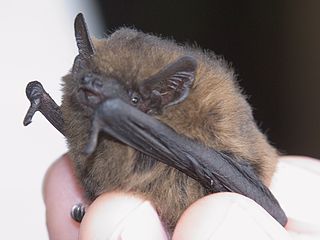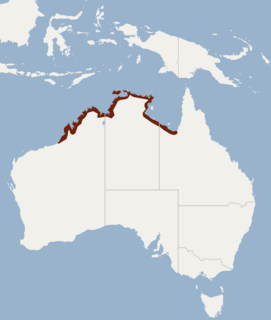
Pipistrellus is a genus of bats in the family Vespertilionidae and subfamily Vespertilioninae. The name of the genus is derived from the Italian word pipistrello, meaning "bat".

The common pipistrelle is a small pipistrelle microbat whose very large range extends across most of Europe, North Africa, South Asia, and may extend into Korea. It is one of the most common bat species in the British Isles. In Europe, the northernmost confirmed records are from southern Finland near 60°N.

The Java pipistrelle is a species of pipistrelle bat found in South and Southeast Asia, including Afghanistan, Bangladesh, Brunei, Cambodia, China, India, Indonesia, Laos, Malaysia, Myanmar, Nepal, Pakistan, Philippines, Singapore, Thailand, and Vietnam. It favors human habitations. A 2010 research paper from the Philippines regarding the prevalence of coronaviruses in bats tested several Java pipistrelle bats.
Sturdee's pipistrelle, also known as the Bonin pipistrelle bat, is a bat that was thought to have lived in Japan before officially becoming extinct in 2000. In 2020 the IUCN changed its official status to "extinct".
The Mount Gargues pipistrelle is a species of vesper bat found in Kenya and believed to be widely distributed across highlands in Ethiopia. It typically lives in subtropical or tropical forests.
The angulate pipistrelle, also known as the New Guinea pipistrelle, is a species of vesper bat found in Papua New Guinea and the Solomon Islands.
The greater Papuan pipistrelle is a species of vesper bat found in Papua New Guinea and Irian Jaya.

Kuhl's pipistrelle is a species of vesper bat that occurs in large areas of North Africa, Southern Europe and West Asia. It lives in temperate forests, subtropical or tropical dry shrubland, Mediterranean-type shrubby vegetation, temperate grassland, rural gardens, and urban areas. It is a rare and infrequent visitor to Britain, usually only detected by sound-recordings.

The Madeira pipistrelle is a species of vesper bat. It is endemic to Azores, Madeira and the Canary Islands.
The lesser Papuan pipistrelle is a species of vesper bat. It can be found in Indonesia and Papua New Guinea.

The Mount Popa pipistrelle is a species of vesper bat. It is found in China, India, Myanmar, Thailand, and Vietnam.
The Dar es Salaam pipistrelle is a species of vesper bat. It is found only in Tanzania. Its natural habitat is subtropical or tropical dry forests.

The narrow-winged pipistrelle is a species of vesper bat. It can be found in Brunei Darussalam, Indonesia, and Malaysia.

The least pipistrelle is a species of vesper bat.

The northern pipistrelle, also known as Koopman's or the mangrove pipistrelle, is a species of vesper bat found only in Australia. It is one of Australia's smallest bat species. On average, it weighs 3 g (0.11 oz).

Anchieta's serotine, formerly known as Anchieta's pipistrelle, is a species of vesper bat. It is found in Angola, Democratic Republic of the Congo, South Africa, Zambia, Zimbabwe and Madagascar. The species inhabits savanna habitats.
Hanak's dwarf bat or Hanak's pipistrelle is a species of bat only found in Cyrenaica, Libya and Crete, Greece.











